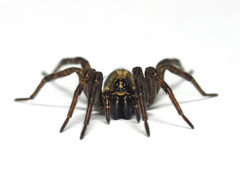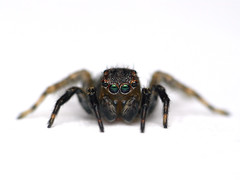 click for large
click for largeMaevia inclemens is a relatively common and colorful jumping spider of North America. Sometimes it is referred to as the Dimorphic Jumping Spider or Blackbodied Jumping Spider.
The species' common name refers to the two different male forms that occur: One is black with yellowish small tufts of black hair on the cephalothorax. The second form, which is grayish with red, white and black markings, resembles the female, which has faint V-shaped markings and a paler abdomen. I really like the yellow palps and zebra striped legs on this little male.
This species is common in the USA. It ranges from New England south to Georgia and west to Nebraska and Oklahoma. It is also found in parts of Canada, for example in southern Quebec.
M. inclemens is the type species for the genus Maevia. The species name is derived from Latin inclemens "cruel, harsh".
The species' common name refers to the two different male forms that occur: One is black with yellowish small tufts of black hair on the cephalothorax. The second form, which is grayish with red, white and black markings, resembles the female, which has faint V-shaped markings and a paler abdomen. I really like the yellow palps and zebra striped legs on this little male.
This species is common in the USA. It ranges from New England south to Georgia and west to Nebraska and Oklahoma. It is also found in parts of Canada, for example in southern Quebec.
M. inclemens is the type species for the genus Maevia. The species name is derived from Latin inclemens "cruel, harsh".



